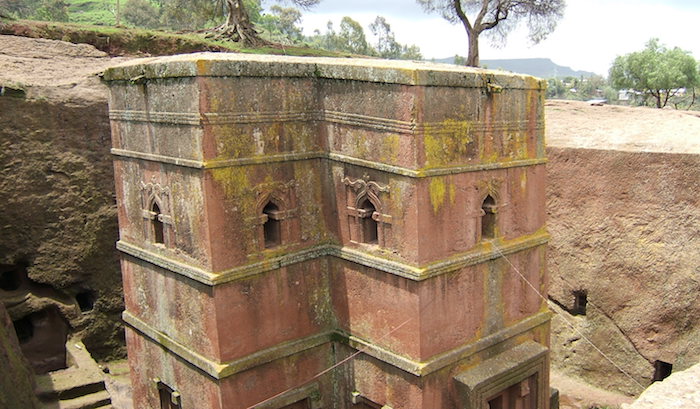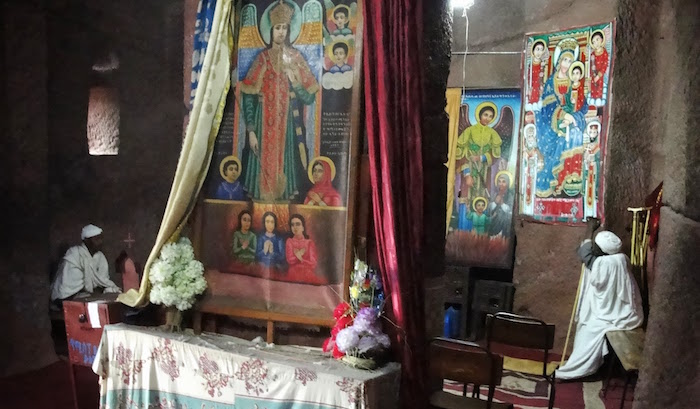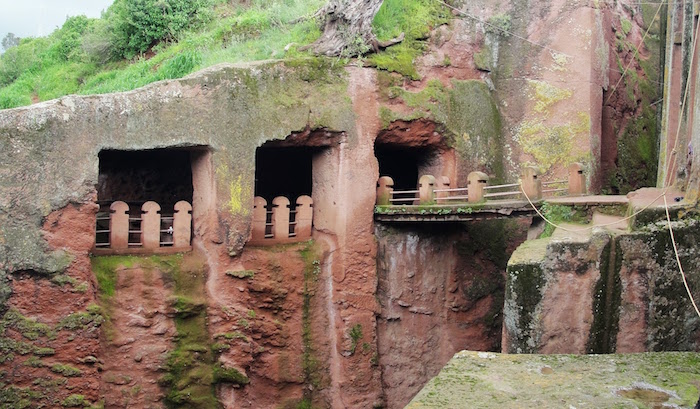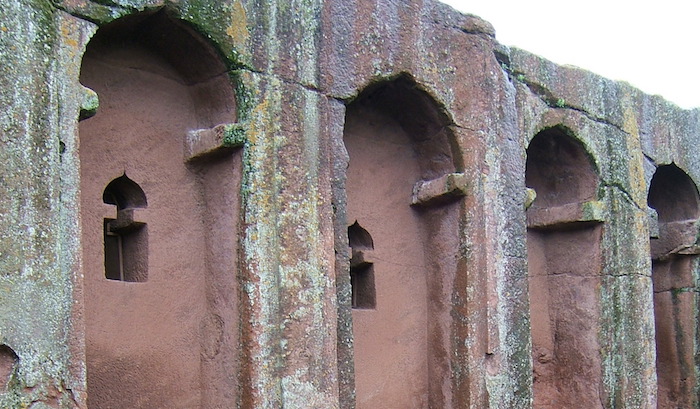The rock-cut churches of Lalibela, Ethiopia, are a marvel. They also have a unique, hard-to-study history that make them well-suited to the gaming table. Let’s take a look at these architectural wonders, then see what a dungeon inspired by Lalibela might look like!
This post is brought to you by beloved Patreon backer Arthur Brown. Thanks for helping keep the lights on! If you want to help keep this blog going alongside Arthur, head over to the Patreon page – and thank you!

The grandest church at Lalibela is the Biete Ghiorgis, the Church of St. George. The building was not constructed, but sculpted. Its roof is flush with the ground around, and its walls are carved out of the rock. Further chisel work has decorated the church with courses, false doors and windows, and a cross etched into the roof. The building’s sculptors hollowed out the center of the church, creating rooms and passageways. Most notable among these is the Holy of Holies where a replica of the Ark of the Covenant (typical of Ethiopian Orthodox churches) resides. The entire building is a single block of stone, still connected to the living rock.
There are a dozen churches at Lalibela, mostly excavated from above like the Biete Ghiorgis. Some are entirely underground! They’re connected by tunnels and grouped into clusters by moats carved into the bedrock. All told, the complex forms a triangle with sides about a quarter-mile long.

The history of Lalibela is harder to study than that of most churches. The faithful say the site was built in a few days by a band of angels working for a 13th-century Ethiopian king named Lalibela. Skeptical archaeologists might dig in the ground to find a secular history, but they have no ground to dig in! Indeed, as the site has been modified over time, each fresh round of carvings removed the evidence of what was there before. Still, there are some clues.
Some of the high walls and ceilings at Lalibela have peculiar little domes and channels carved in them. These are the remains of the uppermost parts of tunnels and chambers carved by the site’s first inhabitants. This means people lived here long before there was a church!
Since the first settlers, the site has seen a series of building projects. Because Lalibela is hewn from the rock, each round of construction can only enlarge and merge existing rooms and dig deeper into the earth. Thus, a ground-level door becomes a second-story window as a church’s base is dug down. A courtyard is further excavated and becomes a cistern. A hallway is expanded and becomes a nave.

Image credit: MarcD. Released under a CC BY-SA 3.0 license.
This is all amazing inspiration for the gaming table. Not only do we have a ready-made dungeon (with an actual reason to exist), we really have a series of dungeons occupying the same place, changing one into another over time. Thus, as we take this magnificent real-life inspiration and fictionalize it, our central theme should be the passage of time.
In the history of our fictional Lalibela, the original site was carved by angels – not as a church, but as a prison. Here, they imprisoned a terrible demon of time and left it to slumber across the centuries. Humans found the cave complex useful as a defensible living space and built a village inside. Here, they would be safe from the terrible dragons that preyed upon them. These early settlers walled off the chamber containing the demon. They had a well-founded dread of the slumbering being chained to the wall!
In real history, Christianity became the state religion of Ethiopia in 330 A.D. (The Ethiopian Orthodox church is one of very few churches outside Europe and the Mediterranean that does not trace its history back to European colonizers.) In this fictionalized Lalibela, we can have the religion of the site’s churches arrive anytime that’s convenient for your setting. They carved out the Lalibela complex in a series of building projects. At one point, the site was overrun by foreign invaders. It was ultimately retaken, and further developed.
In your setting’s modern day, the demon of time still sleeps inside one of the churches. The priests built their Holy of Holies around the demon – not so they could worship it, but so they could place the sleeping monster inside the sacred Ark, better containing it. Unfortunately, some foolish acolyte rattled the Ark and woke the demon. It’s still trapped in the box, but time has grown unstable in Lalibela. Monsters from other eras (anything from dinosaurs to Yithians, depending on your setting) wander the halls. The priests evacuated.

The priests ask the PCs to deal with the problem. They explain that the ark contains a demon of time, that somebody woke it up, and that it’s still imprisoned, but needs to be put back to sleep.
Inside the complex, the PCs find they can choose to phase between three moments in history when the demon was awakened:
1. The present day. The complex is full of monsters dragged here from other times.
2. Centuries ago, when the foreign invaders were looting the site and foolishly opened the Ark. The complex is full of books, scrolls, and tablets dragged here from other times. I’ll call this ‘invader times’.
3. Millennia ago, when dragons were besieging the site and their screams awakened the demon for a few days. The complex is full of historical figures dragged here from other times. I’ll call this ‘ancient times’.
When you choose to phase through time, you don’t change position. That’s great for getting around obstacles! Do you need to bypass a saber-toothed tiger in the present day? Phase back to invader times when it’s not there, walk past where it is, then pop back into the present!
But phasing through time is also dangerous. What if you go back in time and the room you’re standing in hasn’t been excavated yet? The magic shunts you to the nearest excavated space, but you take damage commensurate with the distance. What if you go forward in time and the courtyard you’re standing in has become a cistern? You fall to the ground below and take falling damage!
Time flows at the same rate at all points in history. So if you jump from invader times to ancient times and spend an hour there, then jump back to invader times, an hour will have passed there too.

There is a ritual that will put the demon back to sleep, but you can’t learn it in the present day. Dealing with the demon will force the PCs to engage with the time travel mechanics. That said, provide several ways to learn the ritual! A dungeon with only one solution is dumb!
Solutions you can find in invader times
1. One of the anachronistic books contains the ritual.
2. The foreign invaders have taken the site’s high priest captive. The high priest knows the ritual.
3. The demon is free from the Ark but still chained to the wall. Its chains are long enough to let it reach most of the Holy of Holies, and has eaten every invader in that room. It seems sleepy. If it eats enough human beings, it will need to take a nap.
Solutions you can find in ancient times
1. One of the anachronistic historical figures (maybe a famous prophet the PCs have heard of) knows the ritual.
2. One of the tribal elders living in the caves may be developing the ritual, but needs a little help from an arcane-minded PC.
3. One of the dragons outside may know the ritual, if anyone is brave enough to talk to them.
What happens when you put the demon to sleep in each era?
1. In the present day, it shunts all the monsters back to their appropriate times and shuts off access to time travel to or from the present day. If any PCs are not in the present when this happens, they are stuck in the past forever.
2. In invader times, it shunts the PCs and all the anachronistic books, scrolls, and tablets back to their appropriate times. You can no longer time travel to invader times.
3. In ancient times, it shunts the PCs and all the anachronistic historical figures back to their appropriate times. You can no longer time travel to ancient times.
Putting the demon to sleep in the present day is all that’s needed to appease the priests. Whether the PCs want to put the demon to sleep in invader times and/or ancient times first is up to them.
–
Source: The Golden Rhinoceros: Histories of the African Middle Ages, by François-Xavier Fauvelle (2018)






